New York Times article
June 18, 2006
By David Scharfenberg
Coming Back to Fight
for the Church of Their Ancestors
|
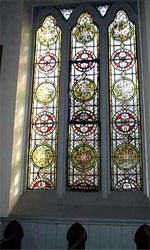 |
IN 1848, as refugees of the Irish potato famine streamed into New York, Irish shipwrights began work on St. Brigid's Church on the eastern edge of Tompkins Square Park.
The church became the community's anchor, but by the late 19th century, most of the Irish had left the neighborhood, and St. Brigid's, known as the Famine Church, was largely forgotten by Irish-Americans eager to bury painful memories of privation.
Even after Cardinal Edward M. Egan closed the church in 2001, calling it structurally unsound, it was St. Brigid's parishioners, mostly Latino, who tried to preserve it. A group of Mexican immigrants sold tamales and tacos once a month to raise money for a restoration fund. A Peruvian contingent held barbecue fund-raisers.
Only after the Archdiocese of New York disbanded the East Village parish in September 2004 and prepared for the church's demolition did Irish-Americans begin to respond to the imminent destruction of a piece of their collective history. "You see all kinds of buildings and monuments," said Paul Dougherty, 52, a video editor whose grandfather worshiped at St. Brigid's, "but very few things bearing the Irish mark."
Mr. Dougherty, who describes the building as "one of the very few landmarks of my people which I can point to," is a volunteer with the Committee to Save St. Brigid's Church, which is trying to preserve the building.
According to Marion Casey, who teaches Irish studies at New York University, the sesquicentennial of the famine also played a role, lifting the silence that had surrounded the event. "I think the Irish are a people for whom history and memory are particularly important," Ms. Casey said. "And there are very few opportunities for memory and the tangible to come together in the way that they have at St. Brigid's."
Early last week, the Grand Council of United Emerald Societies and the Ancient Order of Hibernians, two Irish-American fraternal organizations, aligned themselves with the preservationists. "The church was built by Irish immigrants during the famine years," said Bob Gibson, secretary of the Grand Council. "We'd like to keep their memory alive."
On Thursday night, Pete Hamill, Joseph O'Connor and other Irish and Irish-American writers read from their work at a bar on West 45th Street, raising about $20,000 for the Committee to Save St. Brigid's, which has sued to block the archdiocese's demolition plans.
A State Supreme Court justice dismissed the lawsuit in January, calling it an "impermissible intrusion" into Cardinal Egan's authority. But the group has appealed the decision.
Joseph Zwilling, spokesman for the archdiocese, said he understood the attachment to the church, but said that the building was beyond reasonable repair and that closing the church fit in with a broader realignment of the diocese spurred by demographic shifts. The archdiocese, he suggested, is cool to a recent anonymous offer to buy the church and convert it to an unspecified nonprofit use.
But St. Brigid's partisans like Peg Breen, the great-grandchild of famine immigrants and president of the New York Landmarks Conservancy, aren't quitting. "The Irish," she said, "love a good fight." |
Irish Echo
June 28-July 4, 2006
By Irish Echo staff
'Fervent hope'
AOH top brass asks cardinal to reconsider on St. Brigid's
|
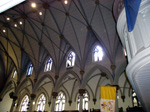
|
The Ancient Order of Hibernians has come out in favor of the preservation of St Brigid's church in Manhattan.
In a letter to New York's Cardinal Edward Egan, the organization's national president, Ned McGinley, called the 1848 structure "unique" and said that is was his "fervent hope" that it be saved.
Local parishioners and conservationists have been fighting a rearguard action to stop the archdiocese's plan to demolish the church, which was built by and for Famine immigrants.
"In facing the real problems of a shortage of religious and in coping with rising costs and legal actions, too often a course of action is determined by the 'bottom-line crowd,'" McGinley said in an accompanying statement.
In the letter to the cardinal -- signed with New York State president, John Hennessy, the New York County president, A.J. Smith, and the AOH's national archivist, Michael Cummings -- McGinley acknowledged that St. Brigid's was a valuable asset that could help pay for diocesan programs. But added: "We ask if it possible to consider those needs without destroying a structure for so long associated with the Irish poor?"
The letter continued: "Would you consider our plea and so many others and review the situation again along with all options?" |
Irish Echo
June 28-July 4, 2006
By Peter McDermott
Echo Opinion: St. Brigid's and the layers of history
|
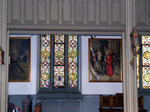
|
There are few better places to meditate upon time and its passing than in front of the Pantheon in Rome. Because that building in the compact Piazza della Rotondo has so influenced Western architecture in recent centuries, it looks familiar, almost new. In fact, however, it would be immediately recognizable to any Roman time-traveler who was alive in or after the year 125 AD, when it was entirely rebuilt.
The city's best-preserved building from the ancient world sits not amongst the famous ruins, but rather in the Historic Center, which is identified with the Renaissance period beginning in the 1300s. When people refer to Rome's layers of history, then, they have in mind places like the Piazza della Rotondo.
America, sometimes called the new Rome, has nothing to compare to it; its greatest metropolis is late into its 4th century, whereas the Eternal City is in its 28th or 29th.
For its defenders, though, the current battle over St. Brigid's church -- built by Irish immigrants early in New York's 3rd century, when it had just a fraction of the populations of London and Paris -- is all about the layers of history.
For those opposed to them, the Catholic church can giveth and it can taketh away. The Pantheon, originally built as a temple to all the gods of Rome's state religion and reconceived by the Emperor Hadrian as an ecumenical space for people who followed different belief systems, was saved from spoliation when it was converted into a Christian place of worship in the 7th century. (Its official name is the Church of Mary and all the Martyr Saints.) By the same logic, St. Brigid's no longer adequately serves its intended function, so it must go.
In a long letter (June 14-20, 2006) to this newspaper defending the plans to demolish St. Brigid's, Victor J. Papa argued that the archdiocese shouldn't be expected to maintain "tired, old church buildings" and should not funnel money into "pre-20th century" structures? How would such an attitude go down in Rome? These days, not very well, I'm sure.
That defender of the archdiocese used the "either/or" argument so popular with politicians. For example, when Gov. Jim McGreevey slashed arts funding in New Jersey a few years ago, he suggested that health, education and welfare were low on his critics' list of priorities. Likewise the archdiocese serves the poor, ergo anything that might tie up funds must be taking away from that endeavor.
That type of reasoning fails on several counts. First of all, pitting one area of spending against another, without reference to the whole, is hardly fair. In the case of the archdiocese, it may be cash-strapped, but it has a lot of property and assets generally. Why must St. Brigid's, a structure that predates all of the city's significant landmarks, fall victim to its cost-cutting exercises?
Second, it sets up a false dichotomy between essential and non-essential spending. The arts, museums and architecture don't necessarily feed people but they are intimately related to the quality of life and to education, too. And this leads on to a third weakness in the argument: it ignores the archdiocese's broader responsibilities to the city and its citizens.
Our letter-writer argued that all New York churches extant in the late 1840s were Famine churches, and that is, of course, true. But many Irish Americans have identified St. Brigid's as important because of the precise circumstances of its construction and its location. People have said they are attracted to the church, which overlooks Tompkins Square Park, for its simple beauty. It certainly seems to stand in stark contrast to the brash, fast-moving, world-famous city that grew up around it. And there's no better place to reflect on the almost 16 decades that have elapsed since the Famine, just as there is no better place to think about the course of human history over two millennia than inside and outside the Pantheon.
One idea that has been suggested by locals who want St. Brigid's reopened as a parish church is to have it also used as an immigrant museum. Victor J. Papa poured particular scorn on this idea, which he identified with the "cocktail elite" -- as if the princes of the church have never relied on the cocktail circuit when raising money for its programs.
Now, a museum may or may not be practical in that space, but the way in which the concept is so easily dismissed epitomizes how the archdiocese is missing what the first George Bush called the "vision thing."
One would have thought that its officials would have jumped at the opportunity to tell the story of New York as a narrative of Catholic immigration and migration.
Just 15 minutes walk to the south of St. Brigid's, the Lower East Side Tenement Museum attracts more than 100,000 visitors annually to 97 Orchard St. Its visionary founder and president Ruth Abram came up with the concept of recounting the lives of real immigrant families who lived in that tenement building from the Civil War through the Great Depression.
A doctoral student in urban education, Lynda Kennedy, who once worked at the Orchard Street venue, told the Echo last year that museums were "extraordinary learning environments" for schoolchildren. She recalled how her late father, an Irish-born Philadelphia homicide detective, brought his children to museums and galleries to make up for the inadequacies of the education system.
The Tenement Museum's next permanent exhibit, which is in the advanced stages of planning, will tell the story of an Irish immigrant family, the Moores, who lived in one its apartments in the 1870s.
Unfortunately, ever since Daniel Patrick Moynihan departed the scene, we haven't had any political or church leaders who understand, as Ruth Abram does, that a city's heritage is to be found, at least partly, in its layers of bricks and mortar and the stories they reveal. |
Irish Echo
June 21-27, 2006
Echo Editorial: Making words count
|
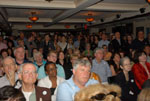
|
Irish Americans, no more than any ethnic community, have rarely been as one on any question; nor perhaps are they ever likely to be. But occasionally, something comes along that strikes a particular chord with the great majority.
Securing the future of St. Brigid's church, built by and for Famine immigrants in New York City in 1848, appears to be one such issue. Nobody has taken a poll on how people feel about that East Village landmark. However, the fact that more than 500 turned out last week for a Midtown Manhattan fundraiser for the Save St. Brigid's Committee is a pretty strong indication that the campaign to stop demolition is gathering pace.
Conservatives, moderates, progressives and those with no discernible political views have expressed their backing for the preservationist cause.
The authors who lent their support at last week's benefit themselves came from across the spectrum in terms of age, perspective and origins. Some of the speakers had Irish accents: Colum McCann, Joseph O'Connor, Anne Maguire, Tom Phelan, Malachy McCourt, Carmel Quinn and the evening's MC, Black 47 front man Larry Kirwan; others were raised in Irish families in American cities: Pete Hamill, Thomas Fleming, T.J. English, Marion Casey, Peter Quinn and Dennis Smith among them.
The local parishioners and activists have battled bravely to stop the wrecking ball. The intervention of outside groups like the Grand Council of United Emerald Societies has boosted their efforts.
But last week's event could someday be seen as a turning point in the campaign to save the church, not so much for the amount of money raised -- $20,000 -- but because it indicated that the Irish community was willing to stand up to defend what it had come to see as an important part of its heritage.
|
Irish Echo
June 21-27, 2006
By Peter McDermott
Stop right there... Save St. Brigid's from wrecking ball: Emeralds
|
 |
A prominent Irish-American organization has offered to help "in any way possible" to save the Famine-era St. Brigid's church in Manhattan.
"We are giving our support," said Tom Gormley, president of the Grand Council of United Emerald Societies, entering the controversy over the 158-year-old East Village structure that the Catholic archdiocese has shuttered and marked for the wrecking ball.
Local parishioners and conservationists have been fighting a rearguard action in the courts over the past year to stop the proposed demolition of the church that was built for and by Famine immigrants.
"We're losing our heritage, the Irish," he said. "They're chipping away at us.
"It's part of our history. It's time we took a stand and defended what we believe in," said Gormley, a retired Westchester police sergeant. "We're entitled to hold onto our own."
He argued that the Famine church in the East Village goes to core of the Irish experience in America. And aside from its initial role giving shelter to immigrants fleeing starvation, it has many interesting footnotes in its long history. For example, he said, the Rev. Thomas I. Mooney, St. Brigid's second pastor, was the first chaplain with the Fighting 69th, a regiment in which the former cop himself has served. It's believed Mooney became involved with the famous unit through its Company C, also known as the Mechanic Guard, which was comprised of shipyard workers from St. Brigid's parish. (The sculpted faces of some of the shipwrights who built the church in 1848-9 adorn its pillars, although locals believe archdiocese officials have removed almost everything of value from the building.)
Gormley added: "One of our members brought it up at a regular meeting and after a discussion we decided to support the cause."
Campaigner Paul Dougherty said that the Save St. Brigid's Committee was "very enthusiastic" about the Emeralds' declaration of support. "It's really lifted our spirits to hear that," he added. "The Emerald societies are to the forefront of all things Irish, such as marching in the St. Patrick's Day parade."
"We can help with letter writing, negotiation and talking to politicians," Gormley said.
Members of the Save St. Brigid's Committee will sit down soon for further consultation with the Grand Council of United Emerald Societies, an umbrella organization with 30 affiliates.
Among the latter are several New York City Emerald societies -- those for the firefighters, Board of Education, Con Edison, telephone, courts', parks', housing and sanitation employees and others -- as well those for the police departments of Nassau, Suffolk and Westchester counties. Each society is entitled to five delegates on the Grand Council.
While several prominent Irish-Americans writers have come together to support the preservation of St. Brigid's, and will speak at a fundraiser next Thursday, this is the first endorsement by a significant mainstream grassroots organization.
The Emeralds' stance might be seen as a measure of the general unhappiness about the way parishes are being closed down.
Gormley, though, said he's cognizant of the church's predicament. "I understand that the diocese is a business and like any business must be run as efficiently as possible," he said. "But there are so many ways to cut back."
The St. Brigid's campaigners have impressed him as "upfront, dedicated people" and he believes, like them, that alternative development plans are viable.
The locals want St. Brigid's, which overlooks Tomkins Square Park, restored as a working parish church, one that that could also be home to an immigrant museum.
"There's no easy answer," commented Dougherty about the church's financial woes. "Any church closing is sad, but we're claiming an historical pedigree.
"My understanding is that the regular court process will come to a head this month," added Dougherty, an independent video editor who lives a few blocks from the threatened church. "There won't be anything to talk about if it's just a mound of rubble. It's a case of speak now or forever hold your peace.
"Irish Americans have to search their souls: do we want to save this or do we want to say goodbye?" he said.
St. Brigid's is believed to be the earliest church still standing associated with Patrick C. Keeley, the County Tipperary-born, Brooklyn-based architect who built an estimated 700 Catholic and Episcopalian houses of worship in North America from the 1840s through the 1890s.
And the Manhattan church was built by Irish labor at the most traumatic moment in Ireland's history.
St. Brigid's continued to be an Irish neighborhood church for more than 50 years; other immigrant groups, such as the Germans and the Italians, were predominant later. Then, Puerto Rican migrants came to the East Village and Lower East Side in the post-World War II era, and close-knit and devout multigenerational families from that community have been to the forefront in the current campaign.
But several Irish-Americans with deep roots in the neighborhood have also been involved in the effort. Dougherty's grandfather was a product of the parish, as were his two great-uncles and a great-aunt from the same family who went into religious life. His brother was married in the church in 1997.
Dougherty said he's met many prominent Irish Americans who were supportive privately of the St. Brigid's cause but "are reticent to say it aloud."
He's hopeful that the Emeralds' 11th hour intervention will change that.
The St. Brigid's Benefit Reading by Irish and Irish-American writers will held on Thursday, June 15, at 7 p.m. at Connolly's 45, 121 West 45th St., (between 6th and 7th Aves, 3rd Floor event room. Speakers include: T.J. English, Thomas Fleming, Pete Hamill, Thomas Kelly, Colum McCann, Joseph O'Connor and Peter Quinn. It will be hosted by Black 47 front man Larry Kirwan. For more details go to www.savestbrigid.com or call (212) 928-9995.
|
The Villager
June 21-27, 2006
By Lincoln Anderson
Irish bards sing a love song for St. Brigidís Church
|
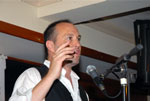 |
Villagers traveled north of 14th St. last Thursday to Connolly's near Times Square to attend "Bards for St. Brigid's," a benefit to raise funds for the legal defense effort to save historic St. Brigid's Church on Avenue B from demolition.
So far, the fight has been waged by the Committee to Save St. Brigid's, a group largely made up of the Puerto Rican parishioners who held services at the church on the east side of Tompkins Square Park until a few years ago, when a crack on one of its walls rendered the building dangerous, according to the Catholic Archdiocese of New York. The archdiocese more recently dissolved St. Brigid's parish and reportedly now plans to reuse the site for some sort of church-related facility.
Although the East Village is no longer an Irish neighborhood as it was 158 years ago when Irish boatwrights built St. Brigid's, Irish-Americans are now at last rallying to the cause of trying to save this "famine church" of the Lower East Side -- one of the churches built to serve the waves of Irish immigrants fleeing the great potato famine.
Paul Dougherty, a video editor who lives in the East Village whose grandfather worshipped at St. Brigid's, organized last Thursday's benefit, along with Larry Kirwan of the Irish rock group Black 47 and Mary Ann Pierce, a friend of Dougherty's who is a Webcaster from the Upper West Side, who sold the tickets online. Six hundred people bought tickets at $20 apiece, St. Brigid's T-shirts were sold for $25 each and $17,000 in total was raised.
It was an evening of readings -- and song -- interspersed with poignant remarks about St. Brigid's. The readings formed a mosaic of the Irish-American experience in all its many facets, from the Troubles in Ireland, to Bobby Sands and the hunger strikers, gays' efforts to march in the New York City St. Patrick's Day Parade and just ribald humor.
"The cause of saving St. Brigid's is not about saving the Irish past and what we came through. It's where we're going," said Pete Hamill, before reading a chapter from his autobiography. "It stands as a symbol for the Chinese and Jews and Italians and Latinos," Hamill said of St. Brigid's.
Carmel Quinn, the singer and storyteller, mockingly referred to Cardinal Edward Egan as "Edward Scissorhands," the moniker he earned in Bridgeport, Conn., before he came to New York.
"God almighty, what's wrong with the cardinal?" she asked. "God knows, he's got enough."
Anne McGuire of the Irish and Lesbian Gay Organization said, "I hope that St. Brigid's is saved because I really don't want another N.Y.U. dorm in the East Village."
There were cheers and someone shouted out a "Yay!" of agreement.
Malachy McCourt, who is running for governor on the Green Party ticket, read an uproarious story from his memoir, "Monk Swimming" about turning the tables on an annoying coat-checker by stripping naked and then putting his overcoat back on before checking it. Then he broke into the traditional courting song "Go, Lassie Go," and suddenly the whole place was singing along with him, everyone knowing the lyrics by heart.
And we'll all go together/to pick that wild mountain thyme/all around the bloomin' heather/Will you go, lassie go?
"Sing it children!" he called out -- probably just as his father did to him and his brothers when they were young, as described in his brother Frank's Pulitzer Prize-winning book, "Angela's Ashes."
Sergeant Conor McCourt, Malachy's son, who supervises the Times Square police, popped in to see what "seditious acts" his father was up to.
After the four-hour marathon had ended, the event's organizers and others stressed it's not too late to save the church. A lawsuit seeking to bar the church's demolition is currently before the Appellate Court.
"It's not too late," said Councilmember Rosie Mendez, who used to attend Mass at St. Brigid's. "The Bible says: 'The faith of a mustard seed -- anything is possible.' Mustard seeds are tiny -- but they grow. It's been a couple of years since they closed the church, and we're still fighting."
"One man has the power to save this church -- and if we can get to him, we can do it," said Black 47's Kirwan, a former East Villager who now lives in Soho.
Although an "angel" with deep pockets has recently come forward saying he wants to buy the building and convert it to nonprofit use, some expressed concern at what this might mean for the historic church. Most said they'd like to see St. Brigid's remain a functioning church, while others also said they'd like to see it become like St. Mark's Church-in-the-Bowery -- a church with an active arts contingent. Kirwan said he'd personally want it to remain a working church, but also become an Irish famine museum.
"The Irish didn't commemorate the famine, because they couldn't understand it -- how God could do this," Kirwan said. "They didn't want to mention it. There were no songs about it."
He noted his band's name, Black 47, is what the famine is called in Ireland.
The boatwrights carved their faces atop the pillars inside the church, he added, quite unusual for Catholicism.
"You can actually see the faces of the people that built it," he said. "We can't afford to let it go.... What are we going to have there? Some new glass and chrome? Stupid. Is that our monument as modern people?"
Irish famine memorials -- "prefab," Kirwan derisively called them -- have been created in Boston and Lower Manhattan, but here on Avenue B is a monument that already exists, he said.
Afterwards, Edwin Torres, a leader of the Committee to Save Brigid's, said, "I think the event was a success. One of our objectives was to make the Irish-Americans aware of this and I think we did that and also there are now more funds for our legal struggle."
"Now it's a citywide, and perhaps a national issue," added Roland Legiardi-Laura of the East Village Community Coalition of the positive P.R. effect of the benefit. Pierce said she's going to try to sell the podcast of the event and also an audiotape to National Public Radio to help get the message out.
Dougherty explained he'd like to see St. Brigid's restored the way the Eldridge St. Project is reviving the Eldridge St. Synagogue.
"It's a tough act to follow," he said. "But, I thought, 'Why can't we do the same thing?' Their system is decentralized. Ours is centralized, hierarchical. It's daunting. They just had to broker a deal with a minyan, the board, whatever. But somehow, something is doable. It's an uphill battle, but there's a shot. Even though it's late in the court process, this is the first time our message has gotten out.
"It just seems foolish to build famine memorials," he said, "If you've got one that's the real deal."
|
TheWildGeese.com
June 29, 2006
Appeals Court Shoots Down Bid To Block Demolition Of City's "Famine Church"
|
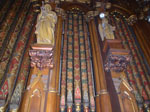 |
A New York State appellate court ruled Thursday that the Archdiocese of New York has the right to demolish a Famine-era church in Manhattan that has become a rallying cry for the metropolitan area's Irish community. Earlier in the year, a state Supreme Court justice dismissed the lawsuit, titled "Committee to Save St. Brigid v. Edward Cardinal Egan," brought by the committee, along with former parishioners of St. Brigid's Church. The church was built in 1848 by Irish shipwrights. The plaintiffs asserted that the archdiocese failed to constitute a board of trustees, consisting of two archdiocesan officials, the church's rector, and two lay people, to make such decisions, a provision they noted was required by state law. A lawyer for the archdiocese claimed that officials would assemble the board before taking further action and that archdiocesan officials were making decisions well within their authority.The case went before the Appellate Division of the state's Supreme Court June 13. In its uncorrected opinion, the court stated, in part: "The court properly found that the disposition of the church property and funds at issue were matters within defendant's ecclesiastical authority, and, accordingly, that the relief sought by plaintiffs, i.e., an order mandating that the funds in question be used to restore the subject property for use as a church, would impermissibly involve the court in the governance and administration of a hierarchical church. "Plaintiffs' promissory estopel claim would, in any event, be unavailing for lack of a specific promise to keep the subject church building in operation as a church if funds were collected for that purpose." The church was built more than 150 years ago as a spiritual home for Roman Catholic immigrants fleeing The Great Hunger. Cardinal Edward M. Egan shut the church in 2001 because of structural problems. Members of the committee announced earlier in the month that someone who insisted on anonymity recently made a new offer to purchase the church, at Avenue B and Eighth Street, from the archdiocese at "fair market value." But Joseph Zwilling, the spokesman for the archdiocese, responded that the offer was not new. About a year ago, he said, someone offered to buy the church, but archdiocesan officials rejected the offer because they wanted to use the land for other purposes. On June 14, the committee produced a benefit titled "Bards for St. Brigid" that headlined more than a dozen New York Irish-American literati, musicians and scholars. The Manhattan event drew more than 500 supporters and garnered $21,000 in donations for the preservation effort, according to the organizers. The money, they announced, was largely earmarked for legal fees incurred by the suit and subsequent appeal. Representatives of two prominent Irish groups, the Grand Council of United Emerald Societies and the Ancient Order of Hibernians, also announced June 13 that their organizations were joining the effort to save the church.
|
The New York Sun
March 16, 2006
By Julia Vitullo-Martin
An Irish Famine Church Decays In East Village
|
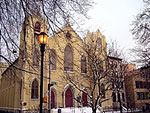 |
"The first thing our ancestors did when they emigrated here was build a church," said Patti Kelly, a stainedglass artist and an organizer of a benefit on Sunday to raise money to save St. Brigid's, a Roman Catholic church on 8th Street and Avenue B, across from Tompkins Square Park. Known as the Irish Famine church,St.Brigid's was built in the late 1840s by poor Irish immigrants who had settled on the teeming Lower East Side to be close to the docks where many worked in backbreaking labor. Today their Carpenter Gothic church is under an order of demolition from the Archdiocese of New York, which says it is structurally unsound. Angry parishioners and neighbors contend that the more important consideration for the archdiocese is that the church's neighborhood, today called the East Village, is one of the hottest in New York. A longtime parishioner, Edwin Torres, said, "For the hierarchy the church is now a business, and the cardinal is the CEO." An East Village resident, Roland Legiardi-Laura, who has lived across the street from St. Brigid's for 28 years, called the building "my friend and neighbor and source of psychic salvation on the block for the last 126 years." The church and its school, which take up an entire block front, constitute what real estate experts say may be the largest remaining developable site facing a major park in Manhattan. All over New York churches and synagogues that were built by immigrants and are seen today by neighbors as permanent fixtures are facing threats to survival that accompany thinning congregations, declining finances, deteriorating structures ó and a strong real estate market that can make some financial problems disappear. The Catholics alone built hundreds of churches ó no one is sure how many, but scholars estimate the number to be more than 1,000, many of which successfully adapted to and embraced the full cycle of immigrants. The mid-19th-century Irish were followed by Germans and Italians, then Slavs, and finally Latinos after World War II. St. Brigid's, which has hosted every group, had become primarily a Latino parish when shuttered by the archdiocese in 2004. Some in the East Village are bitter about the closing. "Why would you do this to believers?" B.G. Firmani asked. "Are there so many believers in the East Village that you would dis them and feel confident that you were doing the right thing?" There is no question that attendance at Catholic churches is in a downward spiral. A historian and co-director of the Curran Center for American Catholic Studies at Fordham University, James Fisher, said the archdiocese does have a genuine substantive problem. "On the one hand there's more religious vitality than ever in New York, an incredible multicultural, unprecedented variety of congregational life, every conceivable tradition globally has come here. There's been a tremendous expansion locally of evangelical Christianity. But what's really struggling are the old mainstream denominations, old-line Protestants, some synagogues, and definitely Euro-American Catholic ethnic parishes." He noted that one solution is the merging of parishes, such as that of St. Bernard's on West 14th Street, founded by Irish longshoremen, with Our Lady of Guadalupe, a large, vital Latino parish that lacked sufficient worship space. But St. Brigid's parishioners do not want to merge.They fought hard to save the church, raising $103,000 mostly from working-class families who contributed the money on top of their weekly offerings. Mr.Torres argues that the church's current deteriorated condition is partly the responsibility of the archdiocese itself, which demolished the old school in the late 1950s. "The school held up the east wall of the church," Mr.Torres said."The wall is almost 60 feet tall and is not concave. They knocked down the school, filled in the hole with rubble, and the massive size and weight of the wall started moving east. The archdiocese hired a contractor, who is now out of business, to shore it up. "Now they say it would take $600,000 to correct the situation. Everything the archdiocese does is grossly exaggerated.We got a bid of $285,000 from one of the best contractors in New York. But they just ignore us." A spokesman for the archdiocese, Joseph Zwilling, said the church building must be demolished, but that it has not yet set a date. Nor has it determined the future use of the property. The school, he said, "will stay in place for the time being." The archdiocese is in the midst of what it calls a "realignment effort" to close underused churches among its 413 parishes, reduce the number of Masses, redeploy priests, and consolidate parishioners. "Our first priority," Mr. Zwilling said, "will be to seek other Catholic uses that could be made for a particular site. A Catholic nursing home is one possibility. Our primary consideration throughout the entire realignment is to continue our ministry even when we close a parish." Nonetheless, the archdiocese is embroiled in fights with parishioners all over New York, particularly in prime neighborhoods like the Village and Harlem. The National Catholic Reporter ran a story last week saying that an Italian-owned Manhattan-based real estate development company with ties to high-ranking Vatican officials had entered into contracts to acquire more than $100 million of church property in three cities in America, including New York. Such reports send shivers of fear through neighborhoods, but particularly among preservationists. The president of the Landmarks Conservancy, Peg Breen, herself the great-granddaughter of Irish Famine immigrants, pointed out that when churches are closed, the archdiocese has often been looking for fair market value for the property. Ms. Breen does not object, but says that in several cases, including St. Brigid's, "the community has identified angel funders willing to come in with real money to acquire the property and restore the church." Mr. Zwilling said there have been offers, but he refuses to discuss them in any detail. Meanwhile, another Catholic parish on the Lower East Side, St.Theresa's at 10 Rutgers St., saved its 1842 Gothic church by selling a parking lot and air rights over the church to a developer for $2.5 million in late 1998. Builder Alan Bell, a principal with the Hudson Companies, called the project a winwin."The key thing is that we were able to use all the zoning there was to build an 83-unit apartment building, which is fully occupied at market rents." Rents range from $1,900 a month for a studio to $4,000 for a two-bedroom. "Even though we're 100% market rents," he added, "we qualified as a depressed neighborhood under the Community Reinvestment Act so that our lender gave us a lower rate." St.Theresa's has a happy ending. On a recent Sunday, parishioners who seemed to represent most of New York's ethnic groups streamed in and out of the church. Mr. Bell said, "They restored their church, and now they're restoring their congregation." Hoping for a similarly happy outcome, parishioners and neighbors of St. Brigid's have sued the archdiocese to forestall demolition. And it turns out the archdiocese doesn't own the church, which was incorporated under the state's religious corporation law. A lawyer who brought the suit on behalf of the Committee to Save St. Brigid's, Harry Kresky, said, "Everyone agrees that the question of whether or not to maintain a church is a religious decision within the power of the cardinal. But the cardinal doesn't own this church, and the archdiocese has no authority to demolish it." The case is now before the Appellate Division of the New York State Supreme Court.
|
The Villager
June 14-20, 2006
By Albert Amateau
Wealthy 'angel'
offers salvation for St. Brigid's Church on Ave.
B
|
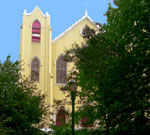 |
Gary Kravetz, the attorney who issued the offer on behalf of the anonymous client, declined in a telephone interview to say whether the offer had been made to the archdiocese yet, and a spokesperson for the archdiocese could not be reached by press deadline for comment.
The offer for the church, built 157 years ago by Irish boat builders on the east side of Tompkins Square Park, was made public at a June 13 news conference with a pronounced Irish flavor in front of the Appellate Division courthouse.
Paul Dougherty, a new member of the Committee to Save St. Brigid's Church, along with representatives of the Grand Council of United Emerald Societies, joined committee president Edwin Torres in pleading their cause near the courthouse steps.
"My grandfather was a parishioner of St. Brigid's and raised eight kids in the neighborhood," said Dougherty, an East Village resident. Dougherty said he got involved with the issue recently after the archdiocese announced its most recent round of church and school closings in Downtown Manhattan.
"I hadn't been going to Mass until I heard that Church of the Nativity [on E. Second St.] was facing closure, and so I started going to Mass there," he said.
"St. Brigid's Church is an extremely important piece of New York, American and Catholic history," said the anonymous benefactor in the statement issued by his lawyer. The building, constructed during the famine year 1848-'49, should be preserved "as a testament to the faith of impoverished immigrants escaping the famine and restrictions on their religion," the statement says, calling on decision makers at the archdiocese to engage with him "to see if a winning outcome is possible for the archdiocese, the neighborhood of St. Brigid's and for historic preservation."
Harry Kresky, attorney for the committee who sued the archdiocese last year to prevent demolition, told the crowd outside the courthouse that part of his argument was based on his contention that the church building really belongs to the St. Brigid board of trustees — five members, including the bishop, the vicar general, the parish priest and two lay members of the parish appointed by the bishop.
But the board has not been active in years and the lay members have not been appointed. The archdiocese contends the three clerical members can make the decision to demolish the church.
Kresky, however, contends that the decision can only be made by a fully constituted board with the two appointed lay members.
"Last year, there was no offer to buy the church and preserve it," he told reporters outside the courthouse. "If there were lay members on the board now, maybe they could bring the other members to their senses and make them consider the proposal," he said.
The historic church has been vacant since 2001 when a crack in the rear wall became so severe that it was declared unsafe and worship was shifted to the basement of the St. Brigid's parish school at the corner of E. Seventh St., which was built in 1959 and continues to be run by the archdiocese.
Nevertheless, in September 2004, the Trinitarian Order, whose priests ran the parish, decided to pull out, and Cardinal Edward Egan dissolved the parish.
Moreover, since 2003, St. Brigid's mostly Latino parishioners had been donating to a fund to rebuild the historic church, and had collected $103,000. The sum, minus about $30,000 that went for parish expenses, is being held by the archdiocese.
Kresky and the committee contend that acceptance of the rebuilding money was a "tacit agreement" to restore the church, designed by Patrick Keely, a 19th-century Irish-American architect. The archdiocese, however, contends that there was no implied promise and has offered to return the money to parishioners who prove they made the donations.
The archdiocese has said it would take $600,000 or more to restore the church to safe use. But, at the June 13 news conference, Torres said that he had engaged an engineering survey of the building and determined that it needed less than $300,000 to restore the building.
Torres noted, however, that last year the archdiocese had removed and taken to storage the interior furnishings, altarpieces and statuary.
The lawyer for the anonymous benefactor said he did not know whether his client's offer to buy the church included the rectory next door, which the archdiocese also intends to demolish and presumably sell to a developer.
More than two years ago, the archdiocese secured an alteration permit to convert the church building into apartments. But that permit was replaced last year when the Department of Buildings issued a demolition permit. The demolition permit is on hold pending the decision by the Appellate Division. The five-judge court is not under any time constraint on when to decide, and Kresky would not hazard a guess.
|
New York Daily News Article
March 23, 2006
By Julia Vitullo-Martin
City's Irish must save their legacy
|
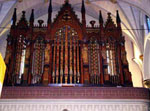 |
Two days before the St. Patrick's Day Parade, the
Archdiocese of New York began erecting scaffolding
around St. Brigid's, known as the Irish Famine Church,
at Avenue B and Eighth St., which earlier received a
demolition permit. Irish boatwrights who worked the East
River docks, which in those days ended at Avenue C,
built the 1848 church out of their hard-won earnings.
The archdiocese claims the back wall is in danger of
collapse and the church itself structurally unsound,
though they've not yet set a date to raze the building.
Because the church and its school sit on a large
developable site facing Tompkins Square Park, the sale
of the cleared land would bring in millions of dollars -
though at the cost of the destruction of an
irreplaceable piece of Irish heritage.
No one at the archdiocese seemed to think there was
anything amiss about the timing of the scaffolding.
St. Brigid's architect was Tipperary-born Patrick
Keely, who became one of the most popular church
architects of his day.
The poverty, degradation and brutality of the famine
are long behind the Irish, who are the second-wealthiest
ethnic group in America, according to demographer Andrew
Greeley. Surely, they can afford to step forward and
save this monument built by their ancestors under the
most dire of conditions.
James Fisher, co-director of the Curran Center for
American Catholic Studies at Fordham University, says
the Irish were the first Catholics in New York and that
they "built the infrastructure -- the hospitals, the
cemeteries, schools and churches, the entire vital
networks -- that allowed the archdiocese to thrive for
decades. They identified the church as the visible sign
of their success and endurance, their sacrifice on
behalf of the church and one another. This historical
sense of legacy cannot be easily discarded."
The Irish of St. Brigid's were so devoted to their
religion that they ranked third in the diocese in
providing funds toward building St.Patrick's Cathedral,
according to the Committee to Save St. Brigid's. Perhaps
the archdiocese could repay the favor. Landmarks
Conservancy President Peg Breen, a great-granddaughter
of famine immigrants, notes that while the prosperous
Irish have often moved to the suburbs, that's no excuse.
"You can't be Irish and not want a good fight," she
says. "Nor can you be Irish and not be nostalgic about
your heritage."
After all, other Irish famine churches have been
lovingly restored. Old St. Patrick's in Chicago, for
example, has a membership of more than 3,500 households,
even though, according to parishioner Margaret
Stapleton, it was virtually abandoned in the 1970s.
Thriving and beautiful once more, Old St. Patrick's
shows how it can be done.
Perhaps the leaders of the archdiocese could make a
trip west to learn from Chicago. |
For more information on how you can help save St. Brigid's Church, please contact:
The Committee to Save St. Brigidís · 280 East 7th Street · New York, NY 10009
Carolyn Ratcliffe at 212-674-4057 · Patti Kelly at 917-582-2274 · Edwin Torres at 212-691-4039
|
 |